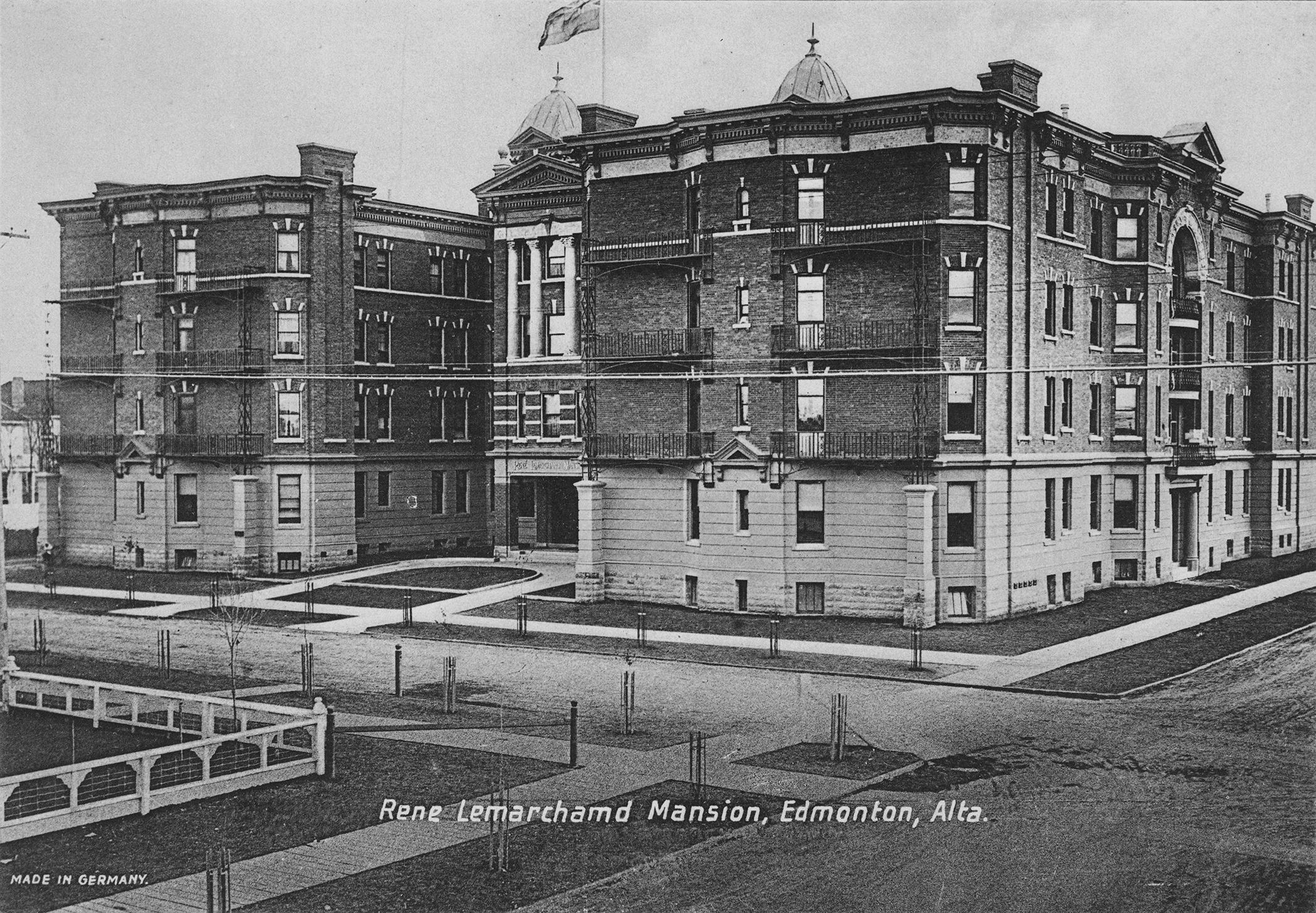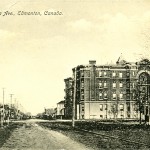Imagine reading in a local newspaper the following description of a building to be built in Edmonton:
A driveway will lead up a circular sweep around a fountain, and a bed of flowers to a wide portico, with escalated pavement, and flanked by a large marble column…The entrance doors…[will] lead into a vestibule, or large entrance hall with a richly decorated ceiling, entirely surrounded with oak-panels having on the right a large inglenook recess with fireplace and space for writing table. On the opposite side of the hall another recess, similarly panelled and finished, will form an antechamber to the “Office” which there will be on the ground floor.
What sort of building do you imagine? A grand estate mansion, perhaps, or a very nice office building? On June 28, 1909, the Edmonton Bulletin published the above description of the in-progress Lemarchand Mansion to be built on 115 Street and 100 Avenue. “Mansion” may be in the name, but the building was one of many apartment buildings constructed during the latter part of Edmonton’s population boom in the early 20th century. This certainly doesn’t sound like the apartment building I live in (which is a fine building!), nor does it sound like any apartment buildings that I know of in 21st century Edmonton.
As Edmontonians-to-be flooded the city just after the turn of the 20th century, it rapidly became apparent that something needed to be done to house these new residents. Some people were able to stay with relatives or in hotels, but for those who weren’t, there seemed to be very few options. Tent cities were erected as a temporary solution, but this was dissatisfying to those who ended up living for two years in their “temporary” dwellings. The idea of apartment buildings came to the forefront. Initially, municipal leaders were concerned that these buildings would only turn into glorified boarding houses–and they were trying to build a respectable city! The prospect of a bustling metropolis on the prairies was exciting, and the notion was encouraged by the arrival of the railway in Strathcona in 1891. This allowed a wider variety and higher quality of goods to travel more easily from Central Canada than ever before , and supported the rapid growth of Edmonton and Strathcona at the turn of the century. “Boosters,” however, were interested in building a staunchly middle-class city as part of their attempts to bring British and Central-Canadian sensibilities westward. How did developers and builders respond to these concerns? By going all out!
These buildings were often built with the latest technologies–telephones in every apartment, for instance. They were also, as exemplified by the description of the Lemarchand Mansion above, built with luxury and strong design elements in mind. Edmonton’s Edwardian-era apartment buildings (the ones that are still standing, including Westminster Apartments, Annamoe Mansion, and Leamington Mansions) are timelessly gorgeous examples of the period’s architecture. Edmonton’s residents responded well: there was a great deal of awe and excitement surrounding the construction of the new buildings. Many people jumped at the opportunity to be free of the work of a big house and yard as well as the proximity to transit and to downtown, where many of them worked.
Let’s look, for example, at J. Percy Page and his wife, Maude. The Pages moved to Edmonton from St. Thomas, Ontario in 1912 in order for him to take a job with Edmonton Public Schools. Page was 25 when he and his wife moved here, and a busy young professional who had been hired by the school board to introduce commercial training into the Edmonton high school system. Not only was he busy professionally, but Page also had an active social life, including participation in the United Church, Rotary, the Mayfair Golf and Country Club, and the Royal Curling Club. While home ownership was typical of white-collar professionals in Edmonton, Page and his wife simply didn’t have time to care for a large house. They became some of the first residents of the Lemarchand Mansion, which was completed in 1912, just as they came to town.
What kinds of amenities were the Pages able to take advantage of in the new building? Well, Rene Lemarchand, the building’s owner, went on record as saying that his ambition was to build the most luxurious apartment building in Canada in an effort to attract upper-class families and singles, so the answer is quite a few. Maude, for example, remembered being quite anxious to get into the building as it was the only place with gas lines in the kitchens–quite advanced for 1912. Other amenities included one of Edmonton’s first elevators for residents and visitors to move between floors easily, electric dumbwaiters for residents to transfer parcels to their suites, one or two fireplaces in each suite, and the availability of a janitor to bring a load of wood up to one’s suite for the fireplace at night for 25 cents. There was also an emphasis on quiet as well as fire safety, with each floor and suite being well-insulated with bricks and mortar. The emphasis on fire safety was taken further with the provision of “fire escapes and iron balconies for almost every tenant” (one feels bad for those tenants without fire escapes, though the Bulletin doesn’t seem to be overly concerned). All this for a rent between $40 and $100 a month!
After the Second World War, the desire for homeownership as part of the Canadian dream saw a distinct upswing. Apartment living was no longer so desirable–people wanted property to call their own. This threatened the continuing success of buildings like the Lemarchand Mansion–all of the building’s lower suites were converted to offices after the war, and today the whole building is occupied by commercial tenants. Similar buildings have similar stories; perhaps the most famous one in Edmonton being the Arlington’s story, with the building seeing a sharp decline after the 1970s and eventually being demolished in the aftermath of a devastating fire. While the Lemarchand Mansion is no longer an apartment building, it’s original facade mostly remains, and tells the story of the first apartment buildings in Edmonton.
While we’re unlikely to see so much luxury in most Edmonton apartments today (though condos are another story), many of the reasons for apartment living remain similar. As young adults launch their careers and social lives, many want to be “close to the action,” both socially and professionally. This is one of the reasons I like living downtown so much: as I often put it, “I’m close to everything”. This includes transit, social and cultural events, and friends. Apartment living also appeals because of the flexibility: just as my young-adult forebearers understood, a house and a yard are a lot to take care of. Someday a standalone house and a plot of land will call my name, but in the meantime, apartment living certainly has its perks. And would I like to live in a manor house-cum-apartment building? Of course I would, but only if I get the suite with the fire escape and balcony!
© Sally Scott 2015


